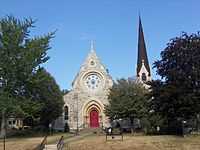Trinity Memorial Episcopal Church (Mapleton, Iowa)
|
Trinity Memorial Episcopal Church | |
 | |
| Location | 302 S. 7th Street, Mapleton, Iowa |
|---|---|
| Coordinates | 42°9′47″N 95°47′18″W / 42.16306°N 95.78833°WCoordinates: 42°9′47″N 95°47′18″W / 42.16306°N 95.78833°W |
| Area | less than one acre |
| Built | 1896 |
| Architect | Edward S. Hammatt |
| Architectural style | Gothic Revival, Romanesque Revival |
| Governing body | Private |
| NRHP Reference # | 90001217[1] |
| Added to NRHP | August 10, 1990 |
Trinity Memorial Episcopal Church is a former parish church in the Episcopal Diocese of Iowa. The historic building is located in Mapleton, Iowa, United States. The church building was listed on the National Register of Historic Places in 1990.[1] The former church building and hall now house the Museum of American History.
History
The church building was built as a memorial to Flora E. (Giddings) Whiting by her husband C.I. Whiting.[2] It was designed in a combination of the Gothic Revival and Romanesque Revival styles by Edward S. Hammatt from Davenport, Iowa. Trinity Memorial was one of at least seven churches he designed in the Diocese of Iowa. In addition, he also designed Kemper Hall, an Episcopal school for boys, and St. Katherine’s Hall, a school for girls, both of which were located in Davenport. Albert and Edmund Jenkinson Contractors of Sioux City, Iowa built the building. The cornerstone was laid on May 28, 1896 by Bishop William Stevens Perry with assistance of the Quarry Lodge No. 404 A.F. & A.M. of Mapleton. The church was consecrated on September 20, 1896. It cost approximately $15,000 to build the church and it was deeded to the Trustees of the Diocese of Iowa the year it was built.[2]
The stain glass windows were donated by St. Thomas Episcopal Church in Sioux City. They had been removed from their former church before it was torn down in 1892. A rectory, which is now a private home, had been built at the same time as the church. The Rev. William Frost was the parish’s first resident priest to live in the house.[2] The Guild Hall was built in 1926.
The Rev. Vine Victor Deloria, first priest of Native American heritage to serve in the Diocese of Iowa, was priest-in-charge at Trinity Memorial, Trinity in Denison, and St. John's in Vail from 1951-1953. After working in Washington, DC he returned to the diocese to serve as vicar at St. Paul's in Durant from 1959-1960 after which he left the diocese.[3]
The funeral of Charles G. Whiting, son of C.I. and Flora Whiting, was the last liturgy celebrated in the church in 1984. Services to deconsecrate the church were held in 1988. The church building and hall were purchased that same year by Keith Robinson for the museum. His collection of political Americana provided the nucleus of the museum’s collection, and remains its primary exhibit.[2] The museum also has artifacts of local interest that appear in the context of significant national events.
References
- ↑ 1.0 1.1 "National Register Information System". National Register of Historic Places. National Park Service. 2010-07-09.
- ↑ 2.0 2.1 2.2 2.3 "The Museum of American History". City of Mapleton. Retrieved 2011-04-13.
- ↑ Horton, Loren N. (2003). The Beautiful Heritage: A History of the Diocese of Iowa. Des Moines: Diocese of Iowa. p. 95.
External links
| ||||||||||||||||||||||||||

